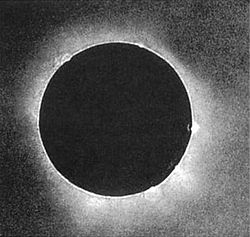| Lists of solar eclipses |
|---|
 |
| Solar eclipses in antiquity |
| Solar eclipses in the Middle Ages |
| Modern history |
| The future |
| Eclipses seen from |
| See also Lists of lunar eclipses |

During the 19th century, there were 242 solar eclipses of which 87 were partial, 77 were annular, 63 were total and 15 were hybrids between total and annular eclipses. [1] [2] In the 19th century, the greatest number of eclipses in one year is five, in 1805, though the years 1801, 1812, 1819, 1823, 1830, 1841, 1848, 1859, 1870, and 1880 had four eclipses each. Two months, January 1805 and December 1880, featured two solar eclipses, on January 1 and January 30 in 1805 and on December 2 and December 31 in 1880. The predictions given here are by Fred Espenak of NASA's Goddard Space Flight Center. [1]
Contents
The longest measured duration in which the Moon completely covered the Sun, known as totality, was during the solar eclipse of August 7, 1850. This total solar eclipse had a maximum duration of 6 minutes and 50 seconds. The longest possible duration of a total solar eclipse is 7 minutes and 32 seconds. The longest annular solar eclipse of the 19th century took place on October 30, 1883, with a duration of 10 minutes and 17 seconds. The maximum possible duration is 12 minutes and 29 seconds. Four instances of back-to-back hybrid solar eclipses within a period of less than six months occurred in the 19th century. The first instance occurred on June 6 and November 29, 1807; the second instance occurred on June 16 and December 9, 1825; the third instance occurred on October 20, 1827 and April 14, 1828; and the fourth instance occurred on October 30, 1845 and April 25, 1846. [a]
The table contains the date and time of the greatest eclipse (in dynamical time), which in this case is the time when the axis of the Moon's shadow cone passes closest to the centre of Earth; this is in (Ephemeris Time). The number of the saros series that the eclipse belongs to is given, followed by the type of the eclipse (either total, annular, partial or hybrid), the gamma of the eclipse (how centrally the shadow of the Moon strikes the Earth), and the magnitude of the eclipse (the fraction of the Sun's diameter obscured by the Moon). For total and annular eclipses, the duration of the eclipse is given, as well as the location of the greatest eclipse (the point of maximum eclipse) and the path width of the total or annular eclipse. The geographical areas from which the eclipse can be seen are listed along with a chart illustrating each eclipse's respective path. [3]




















































































































































































































































